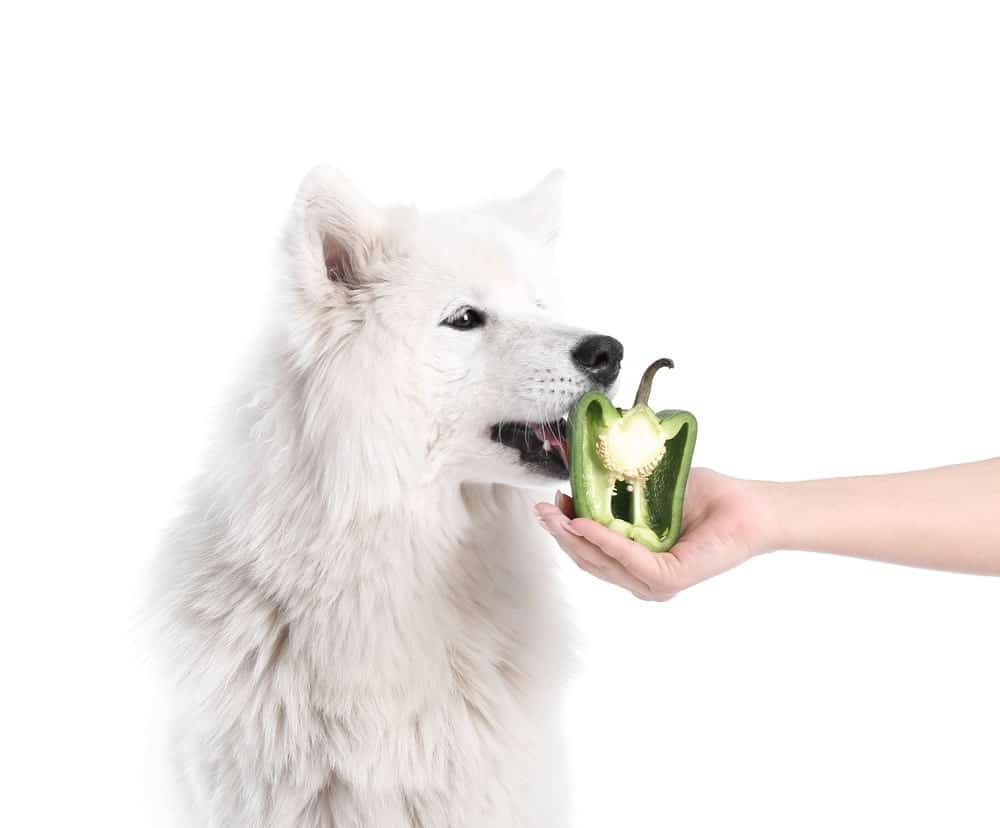When my Beagle-Lab mix, Max, crunched a red bell pepper from my Whole Foods grocery bag, I called my Seattle-based vet, Dr. Emily Carter, to confirm it was safe. She assured me that sweet bell peppers are a nutritious, low-calorie treat in moderation, packed with vitamins, but spicy peppers or overfeeding can cause upset. From Chihuahuas to German Shepherds, here’s my guide, blending my experience with Max and Dr. Carter’s expertise, to help dog owners use bell peppers safely.
Can Dogs Eat Bell Peppers?
Yes, in moderation, says Dr. Carter. Sweet bell peppers (~2.5g fiber/100g, ~20 kcal/100g, e.g., Driscoll’s) are safe for Labs, offering vitamins and hydration. Avoid spicy peppers (e.g., jalapeños) with capsaicin, which irritates Pugs. Max loves red ones [web:13][1].
What Are the Health Benefits of Bell Peppers for Your Dog?
Dr. Carter details (per 100g, red bell pepper):
- Fiber: ~2.5g, aids digestion in Yorkies.
- Vitamin A (Beta Carotene): ~2854 µg, supports vision and skin in Beagles.
- Vitamin C: ~128mg, boosts immunity in Labs.
- Vitamin E: ~1.6mg, supports metabolism in German Shepherds.
- Vitamin K: ~4.9µg, aids clotting in Chihuahuas.
- Antioxidants: Reduce inflammation, no proven disease prevention.
Benefits include:
- Digestive Health: Fiber reduces diarrhea in Pugs.
- Immune Support: Vitamins strengthen defenses in Labs.
- Hydration: ~92% water refreshes Beagles.
- Low-Calorie: ~20 kcal/100g, ideal for overweight Yorkies.
Max stays healthy with small bites [web:21][2].
What Are the Nutritional Benefits to Your Dog from Eating Bell Peppers?
Dr. Carter explains:
- Vitamins: A (
2854 µg), C (128mg), E (1.6mg), K (4.9µg) support coat, eyes, and immunity in Beagles. Red peppers have2x beta-carotene of green (1490 µg). - Minerals: Potassium (
211mg), magnesium (12mg) aid heart health in Labs. - Antioxidants: Carotenoids reduce inflammation in Pugs, no cancer prevention evidence.
- Low-Fat: ~0.2g fat/100g, great for Chihuahuas on diets.
Max’s coat shines from peppers [web:13][3].
How Many Bell Peppers Can Your Dog Eat?
Dr. Carter’s guidelines (2–3 times weekly, <10% daily calories):
- Small Dogs/Puppies (e.g., Chihuahua, 5–10 lbs): 2–3 slices (~20–30g, ~4–6 kcal).
- Medium Dogs (e.g., Beagle, 15–39 lbs): ¼–½ pepper (~50–100g, ~10–20 kcal, Max’s limit).
- Large Dogs (e.g., German Shepherd, 40+ lbs): ½–1 pepper (~100–200g, ~20–40 kcal).
Start with one slice, monitor for upset in Pugs. Max gets a quarter pepper [web:21][1].
How Much Can Dogs Daily Eat Bell Pepper?
Dr. Carter advises occasional use, not daily, for Labs:
- Small Dogs: 1–2 slices (~10–20g, ~2–4 kcal).
- Medium Dogs: 3–4 slices (~30–50g, ~6–10 kcal).
- Large Dogs: ¼–½ pepper (~50–100g, ~10–20 kcal).
Excess risks diarrhea in Chihuahuas. Max sticks to weekly treats [web:13][2].
Can Dogs Eat Bell Peppers Cooked?
Yes, says Dr. Carter. Steamed or boiled peppers (~2g fiber/100g) are easier to digest for Yorkies. Avoid oils or seasonings (e.g., garlic) for Beagles. Max loves steamed slices [web:21][3].
Can Dogs Eat Bell Peppers Raw?
Yes, says Dr. Carter. Raw peppers (~2.5g fiber/100g) are crunchy and safe for Labs if washed, deseeded, and chopped into bite-sized pieces. Max enjoys raw red peppers [web:13][1].
Can Dogs Eat Mini Sweet Peppers?
Yes, says Dr. Carter. Mini sweet peppers (~2g fiber/100g, e.g., Driscoll’s) are safe in moderation for Beagles. Remove seeds to prevent choking in Chihuahuas. Max likes them [web:21][2].
Can Dogs Eat Bell Pepper Leaves?
No, says Dr. Carter. Leaves (~3g fiber/100g) are non-toxic but fibrous, risking upset in Pugs. Stick to flesh for Labs. Max avoids them [web:13][3].
Can Dogs Eat Red Pepper Hummus?
No, says Dr. Carter. Hummus (~6g fat/100g, e.g., Sabra) contains garlic, onion, or salt, toxic to Beagles. Plain peppers are safer for Yorkies. Max skips it [web:21][1].
What to Do If Your Dog Eats Bell Peppers?
Dr. Carter’s steps for Max:
- Small Amount, Plain: Monitor for 24 hours for diarrhea in Pugs.
- Spicy Peppers/Toxic Additives: Call vet or ASPCA Poison Control (888-426-4435).
- Symptoms: Watch for vomiting, lethargy (2–12 hours) in Labs.
- Vet Care: May need fluids for upset in Beagles.
Max’s pepper snack was safe [web:13][2].
Safe Alternatives
Dr. Carter recommends:
- Veggies: Carrots or green beans for Yorkies.
- Fruits: Blueberries or apples for Labs.
- Dog Treats: Low-calorie chews (e.g., Zuke’s, at Petco).
Max loves carrots [3].
FAQs
- Are Bell Peppers Safe? Yes, sweet ones in moderation.
- Can Dogs Eat Spicy Peppers? No, capsaicin risks upset.
- Can Dogs Eat Leaves? No, risks digestive issues.
- What If My Dog Eats Hummus? Call vet if toxic ingredients.
- Safe Treats? Veggies, fruits, or dog chews.
Key Takeaways
- Bell Peppers Safe: Sweet, in small amounts.
- Avoid Spicy/Leaves: Risks upset or irritation.
- Moderate Portions: Prevent digestive issues.
- Safer Snacks: Veggies, fruits, or dog treats.
Final Thoughts
Max’s bell pepper adventure taught me to serve them sweet and seed-free, thanks to Dr. Carter’s advice. Dog owners can find peppers at Whole Foods or Driscoll’s products but should prepare them properly for any breed, from Pomeranians to Mastiffs. Choose safe treats, monitor for symptoms, and consult your vet for a healthy pup!
References:
[1] PetMD, “Foods Safe for Dogs”.
[2] AKC, “Dog Nutrition Guide”.
[3] AVMA, “Pet Food Safety”.
